2000 MERCEDES-BENZ S500 Child safety
[x] Cancel search: Child safetyPage 4 of 421

1 Contents
IntroductionProduct information .......................... 7
Operator’s manual ............................. 8
Where to find it ................................ 13
Reporting Safety Defects ................ 15Instruments and controlsInstruments and controls ............... 18
Door control panel ....................... 20
Overhead control panel ............... 21
Dashboard ..................................... 22
Center console .............................. 24OperationVehicle keys ...................................... 28
Start lock-out .................................... 32
General notes on the
central locking system ............... 33
Central locking system ................... 34
Radio frequency and
infrared remote control ............... 34
KEYLESS-GO ................................. 38Opening and
closing windows and
sliding / pop-up roof
from outside ................................. 45
Panic button ................................. 47
Mechanical keys .......................... 47
Doors ................................................. 48
Power closing assist for
doors and trunk lid .................... 50
Central locking switch .................... 50
Automatic central locking .............. 52
Emergency unlocking
in case of accident ...................... 52
Trunk ................................................. 53
Trunk lid release switch ................ 57
Trunk lid release/close switch ...... 58
Trunk lid emergency release .........61
Antitheft alarm system ................... 62
Tow-away alarm ............................... 64
Easy-entry/exit feature .................. 66
Front seat adjustment ..................... 67
Removal and installation
of front seat head restraints ..... 72
Lumbar support ............................... 73Multicontour backrest ..................... 73
Seat heater ........................................ 75
Seat ventilation system ................... 78
Rear seat head restraints ................ 80
Power head restraints, rear ............ 81
Power seats, rear .............................. 82
Seat belts and integrated
restraint system .......................... 84
Seat belts ........................................... 84
Seat belt nonusage
warning system ........................... 85
BabySmart
TM airbag
deactivation system .................... 91
Self-test BabySmart
TM
without special child
seat installed ................................. 91
Supplemental Restraint
System (SRS) ............................... 92
Emergency tensioning
retractor (ETR) ............................. 93
Airbags .............................................. 94
Safety guidelines for the
seat belt, emergency
tensioning retractor
and airbag .................................. 100
Page 29 of 421

26 Contents - Operation
Te ch n ica l
data Instruments
and controlsOperationDrivingInstrument
cluster displayPractical hints Car care Index
OperationVehicle keys ...................................... 28
Start lock-out .................................... 32
General notes on the
central locking system ............... 33
Central locking system ................... 34
Radio frequency and
infrared remote control ............... 34
KEYLESS-GO ................................. 38
Opening and
closing windows and
sliding / pop-up roof
from outside .................................. 45
Panic button .................................. 47
Mechanical keys ........................... 47
Doors .................................................. 48
Power closing assist for
doors and trunk lid ..................... 50
Central locking switch .................... 50
Automatic central locking .............. 52
Emergency unlocking
in case of accident ...................... 52
Trunk ................................................. 53
Trunk lid release switch ................. 57Trunk lid release/close switch ...... 58
Trunk lid emergency release .........61
Antitheft alarm system ................... 62
Tow-away alarm ............................... 64
Easy-entry/exit feature .................. 66
Front seat adjustment ..................... 67
Removal and installation
of front seat head restraints ..... 72
Lumbar support ............................... 73
Multicontour backrest .................... 73
Seat heater ........................................ 75
Seat ventilation system .................. 78
Rear seat head restraints ............... 80
Power head restraints, rear ............ 81
Power seats, rear ............................. 82
Seat belts and integrated
restraint system .......................... 84
Seat belts .......................................... 84
Seat belt nonusage
warning system .......................... 85
BabySmart
TM airbag
deactivation system ....................91Self-test BabySmart
TM
without special child
seat installed ................................. 91
Supplemental Restraint
System (SRS) ............................... 92
Emergency tensioning
retractor (ETR) ............................. 93
Airbags .............................................. 94
Safety guidelines for the
seat belt, emergency
tensioning retractor
and airbag .................................. 100
Infant and child restraint
systems ....................................... 102
Steering wheel adjustment .......... 105
Rear view mirrors .......................... 106
Memory function ............................ 111
Instrument cluster ..........................114
Multifunction steering wheel,
multifunction display ............... 120
Trip and main odometer,
FSS, tire inf lation pressure
monitor and engine oil level
indicator ..................................... 124
Audio systems ............................. 125
Page 73 of 421
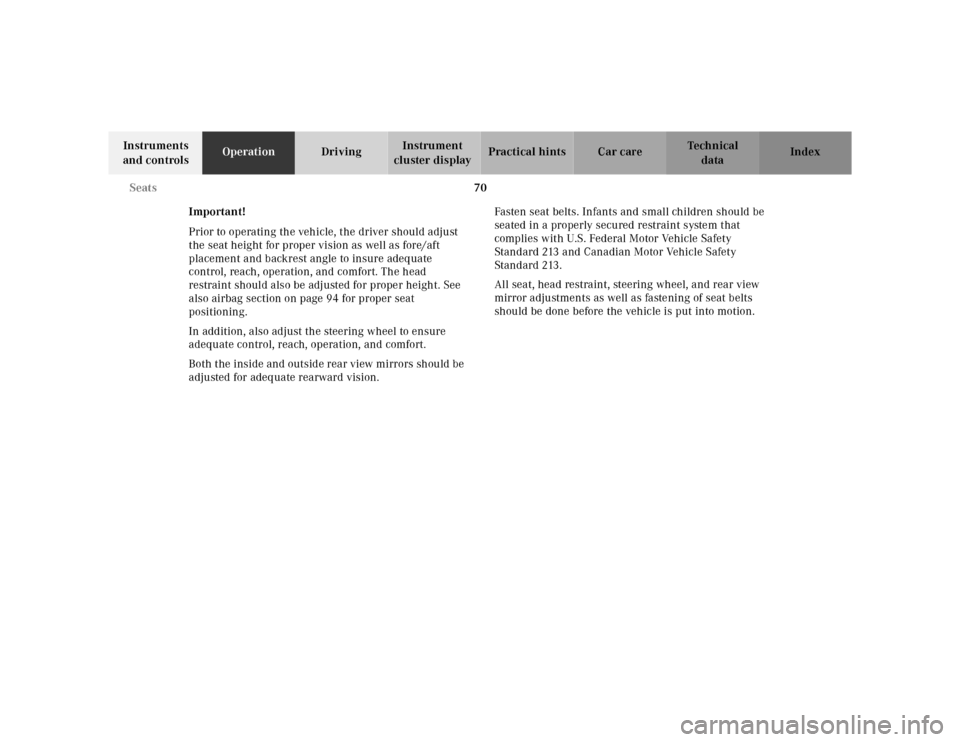
70 Seats
Te ch n ica l
data Instruments
and controlsOperationDrivingInstrument
cluster displayPractical hints Car care Index
Important!
Prior to operating the vehicle, the driver should adjust
the seat height for proper vision as well as fore/aft
placement and backrest angle to insure adequate
control, reach, operation, and comfort. The head
restraint should also be adjusted for proper height. See
also airbag section on page 94 for proper seat
positioning.
In addition, also adjust the steering wheel to ensure
adequate control, reach, operation, and comfort.
Both the inside and outside rear view mirrors should be
adjusted for adequate rearward vision.Fasten seat belts. Infants and small children should be
seated in a properly secured restraint system that
complies with U.S. Federal Motor Vehicle Safety
Standard 213 and Canadian Motor Vehicle Safety
Stand ard 213.
All seat, head restraint, steering wheel, and rear view
mirror adjustments as well as fastening of seat belts
should be done before the vehicle is put into motion.
Page 87 of 421
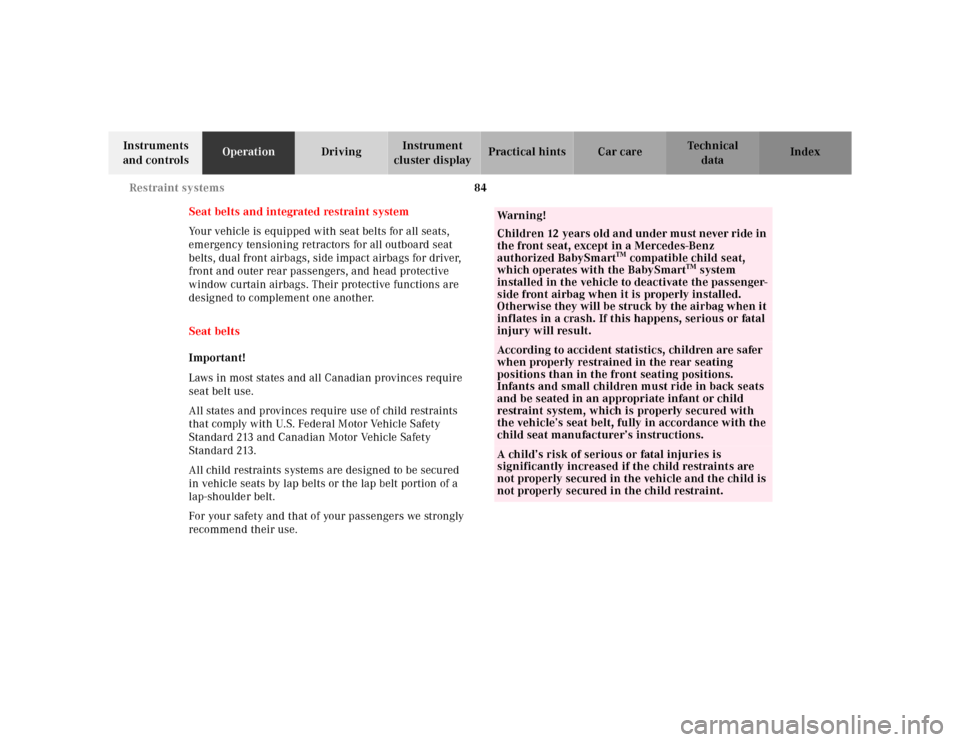
84 Restraint systems
Te ch n ica l
data Instruments
and controlsOperationDrivingInstrument
cluster displayPractical hints Car care Index
Seat belts and integrated restraint system
Your vehicle is equipped with seat belts for all seats,
emergency tensioning retractors for all outboard seat
belts, dual front airbags, side impact airbags for driver,
front and outer rear passengers, and head protective
window curtain airbags. Their protective functions are
designed to complement one another.
Seat belts
Important!
Laws in most states and all Canadian provinces require
seat belt use.
All states and provinces require use of child restraints
that comply with U.S. Federal Motor Vehicle Safety
Standard 213 and Canadian Motor Vehicle Safety
Standard 213.
All child restraints systems are designed to be secured
in vehicle seats by lap belts or the lap belt portion of a
lap-shoulder belt.
For your safety and that of your passengers we strongly
recommend their use.
Wa r n i n g !
Children 12 years old and under must never ride in
the front seat, except in a Mercedes-Benz
authorized BabySmart
TM compatible child seat,
which operates with the BabySmart
TM system
installed in the vehicle to deactivate the passenger-
side front airbag when it is properly installed.
Otherwise they will be struck by the airbag when it
inflates in a crash. If this happens, serious or fatal
injury will result.
According to accident statistics, children are safer
when properly restrained in the rear seating
positions than in the front seating positions.
Infants and small children must ride in back seats
and be seated in an appropriate infant or child
restraint system, which is properly secured with
the vehicle’s seat belt, fully in accordance with the
child seat manufacturer’s instructions.A child’s risk of serious or fatal injuries is
significantly increased if the child restraints are
not properly secured in the vehicle and the child is
not properly secured in the child restraint.
Page 105 of 421
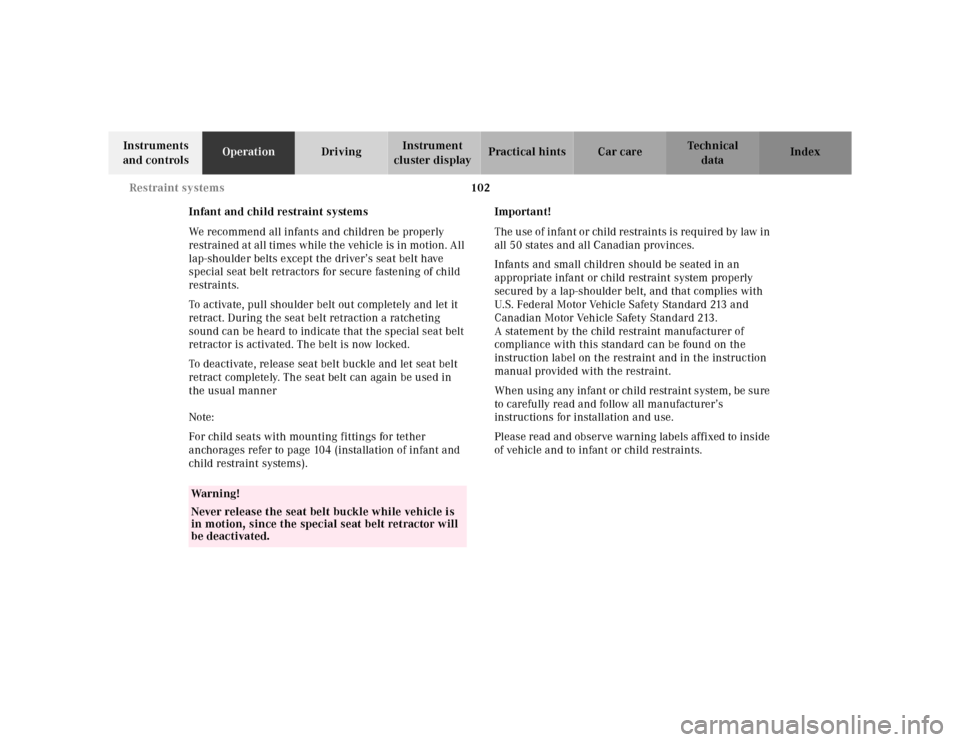
102 Restraint systems
Te ch n ica l
data Instruments
and controlsOperationDrivingInstrument
cluster displayPractical hints Car care Index
Infant and child restraint systems
We recommend all infants and children be properly
restrained at all times while the vehicle is in motion. All
lap-shoulder belts except the driver’s seat belt have
special seat belt retractors for secure fastening of child
restraints.
To activate, pull shoulder belt out completely and let it
retract. During the seat belt retraction a ratcheting
sound can be heard to indicate that the special seat belt
retractor is activated. The belt is now locked.
To deactivate, release seat belt buckle and let seat belt
retract completely. The seat belt can again be used in
the usual manner
Note:
For child seats with mounting fittings for tether
anchorages refer to page 104 (installation of infant and
child restra int systems).Important!
The use of infant or child restraints is required by law in
all 50 states and all Canadian provinces.
Infants and small children should be seated in an
appropriate infant or child restraint system properly
secured by a lap-shoulder belt, and that complies with
U.S. Federal Motor Vehicle Safety Standard 213 and
Canadian Motor Vehicle Safety Standard 213.
A statement by the child restraint manufacturer of
compliance with this standard can be found on the
instruction label on the restraint and in the instruction
manual provided with the restraint.
When using any infant or child restraint system, be sure
to carefully read and follow all manufacturer’s
instructions for installation and use.
Please read and observe warning labels affixed to inside
of vehicle and to infant or child restraints.
Wa r n i n g !
Never release the seat belt buckle while vehicle is
in motion, since the special seat belt retractor will
be deactivated.
Page 107 of 421
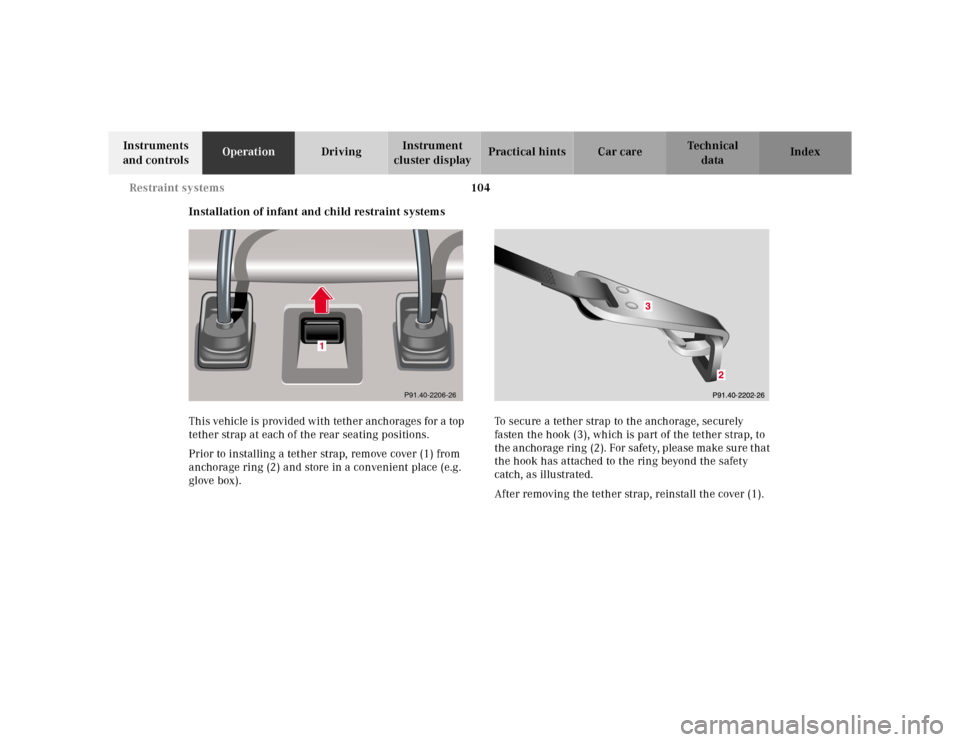
104 Restraint systems
Te ch n ica l
data Instruments
and controlsOperationDrivingInstrument
cluster displayPractical hints Car care Index
Installation of infant and child restraint systems
This vehicle is provided with tether anchorages for a top
tether strap at each of the rear seating positions.
Prior to installing a tether strap, remove cover (1) from
anchorage ring (2) and store in a convenient place (e.g.
glove box).To secure a tether strap to the anchorage, securely
fasten the hook (3), which is part of the tether strap, to
the anchorage ring (2). For safety, please make sure that
the hook has attached to the ring beyond the safety
catch, as illustrated.
After removing the tether strap, reinstall the cover (1).
P91.40-2206-26
1
Page 116 of 421

113 Memory function
Te ch n ica l
data Instruments
and controlsOperationDrivingInstrument
cluster displayPractical hints Car care Index Important!
Prior to operating the vehicle, the driver should check
and adjust if necessary the seat height, seat position
fore and aft, and backrest angle to insure adequate
control, reach and comfort. The head restraint should
also be adjusted for proper height. See also airbag
section for proper seat positioning.
In addition, also adjust the steering wheel to ensure
adequate control, reach, operation and comfort. Both the
inside and outside rear view mirrors should be adjusted
for adequate rearward vision.
Fasten seat belts. Infants and small children should be
seated in a properly secured restraint system that
complies with U.S. Federal Motor Vehicle Safety
Standard 213 and Canadian Motor Vehicle Safety
Standard 213.
All seat, head restraint, steering wheel, and rear view
mirror adjustments as well as fastening of seat belts
should be done before the vehicle is put into motion.
Wa r n i n g !
Children 12 years old and under must never ride in
the front seat, except in a Mercedes-Benz
authorized BabySmart
TM compatible child seat,
which operates with the BabySmart
TM system
installed in the vehicle to deactivate the passenger-
side front airbag when it is properly installed.
Otherwise they will be struck by the airbag when it
inflates in a crash. If this happens, serious or fatal
injury can result.
According to accident statistics, children are safer
when properly restrained in the rear seating
positions than in the front seating positions.
Infants and small children must ride in back seats
and be seated in an appropriate infant or child
restraint system, which is properly secured with
the vehicle’s seat belt, fully in accordance with the
child seat manufacturer’s instructions.A child’s risk of serious or fatal injuries is
significantly increased if the child restraints are
not properly secured in the vehicle and the child is
not properly secured in the child restraint.
Page 302 of 421
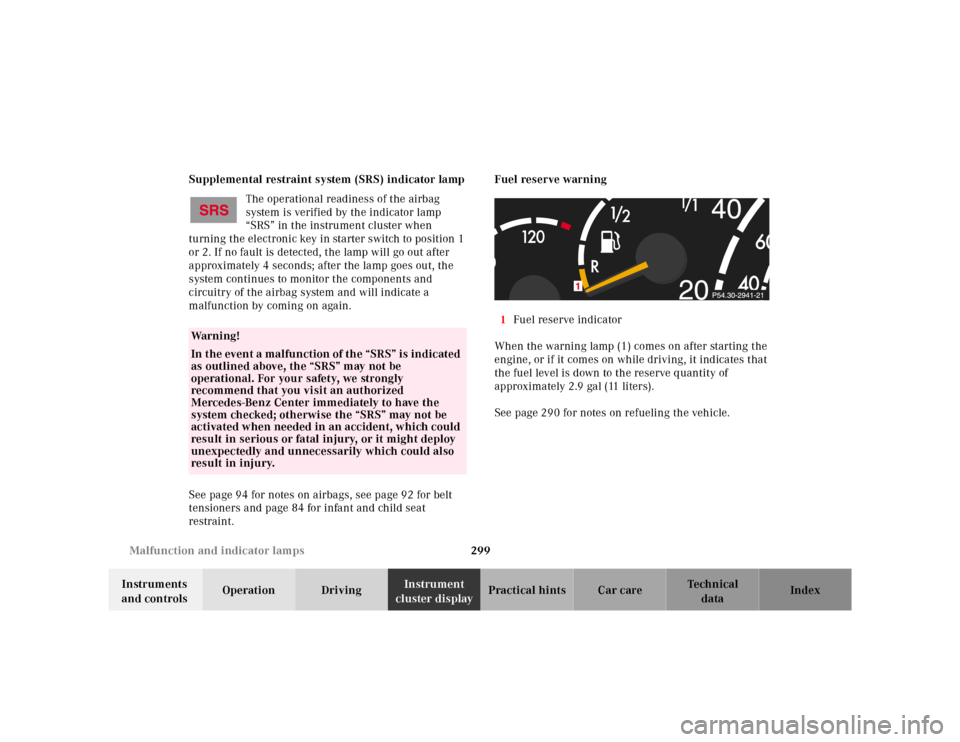
299 Malfunction and indicator lamps
Te ch n ica l
data Instruments
and controlsOperation DrivingInstrument
cluster displayPractical hints Car care Index Supplemental restraint system (SRS) indicator lamp
The operational readiness of the airbag
system is verified by the indicator lamp
“SRS” in the instrument cluster when
turning the electronic key in starter switch to position 1
or 2. If no fault is detected, the lamp will go out after
approximately 4 seconds; after the lamp goes out, the
system continues to monitor the components and
circuitry of the airbag system and will indicate a
malfunction by coming on again.
See page 94 for notes on airbags, see page 92 for belt
tensioners and page 84 for infant and child seat
restraint.Fuel reserve warning
1Fuel reserve indicator
When the warning lamp (1) comes on after starting the
engine, or if it comes on while driving, it indicates that
the fuel level is down to the reserve quantity of
approximately 2.9 gal (11 liters).
See page 290 for notes on refueling the vehicle.
Wa r n i n g !
In the event a malfunction of the “SRS” is indicated
as outlined above, the “SRS” may not be
operational. For your safety, we strongly
recommend that you visit an authorized
Mercedes-Benz Center immediately to have the
system checked; otherwise the “SRS” may not be
activated when needed in an accident, which could
result in serious or fatal injury, or it might deploy
unexpectedly and unnecessarily which could also
result in injury.